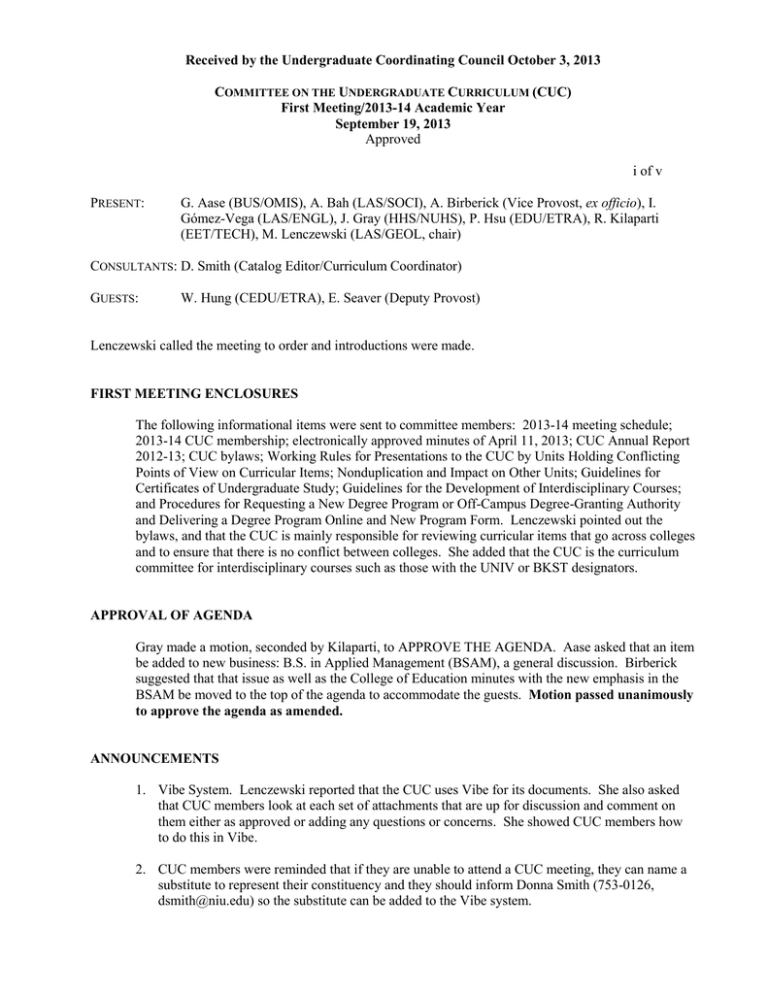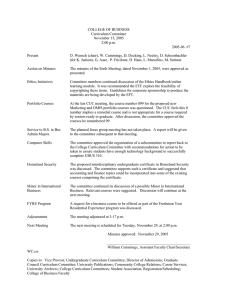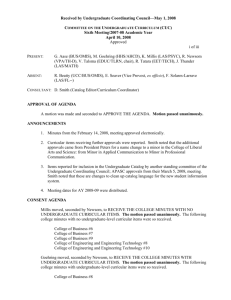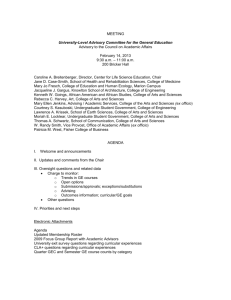Document 15173499
advertisement

Received by the Undergraduate Coordinating Council October 3, 2013 COMMITTEE ON THE UNDERGRADUATE CURRICULUM (CUC) First Meeting/2013-14 Academic Year September 19, 2013 Approved i of v PRESENT: G. Aase (BUS/OMIS), A. Bah (LAS/SOCI), A. Birberick (Vice Provost, ex officio), I. Gómez-Vega (LAS/ENGL), J. Gray (HHS/NUHS), P. Hsu (EDU/ETRA), R. Kilaparti (EET/TECH), M. Lenczewski (LAS/GEOL, chair) CONSULTANTS: D. Smith (Catalog Editor/Curriculum Coordinator) GUESTS: W. Hung (CEDU/ETRA), E. Seaver (Deputy Provost) Lenczewski called the meeting to order and introductions were made. FIRST MEETING ENCLOSURES The following informational items were sent to committee members: 2013-14 meeting schedule; 2013-14 CUC membership; electronically approved minutes of April 11, 2013; CUC Annual Report 2012-13; CUC bylaws; Working Rules for Presentations to the CUC by Units Holding Conflicting Points of View on Curricular Items; Nonduplication and Impact on Other Units; Guidelines for Certificates of Undergraduate Study; Guidelines for the Development of Interdisciplinary Courses; and Procedures for Requesting a New Degree Program or Off-Campus Degree-Granting Authority and Delivering a Degree Program Online and New Program Form. Lenczewski pointed out the bylaws, and that the CUC is mainly responsible for reviewing curricular items that go across colleges and to ensure that there is no conflict between colleges. She added that the CUC is the curriculum committee for interdisciplinary courses such as those with the UNIV or BKST designators. APPROVAL OF AGENDA Gray made a motion, seconded by Kilaparti, to APPROVE THE AGENDA. Aase asked that an item be added to new business: B.S. in Applied Management (BSAM), a general discussion. Birberick suggested that that issue as well as the College of Education minutes with the new emphasis in the BSAM be moved to the top of the agenda to accommodate the guests. Motion passed unanimously to approve the agenda as amended. ANNOUNCEMENTS 1. Vibe System. Lenczewski reported that the CUC uses Vibe for its documents. She also asked that CUC members look at each set of attachments that are up for discussion and comment on them either as approved or adding any questions or concerns. She showed CUC members how to do this in Vibe. 2. CUC members were reminded that if they are unable to attend a CUC meeting, they can name a substitute to represent their constituency and they should inform Donna Smith (753-0126, dsmith@niu.edu) so the substitute can be added to the Vibe system. Received by the Undergraduate Coordinating Council October 3, 2013 COMMITTEE ON THE UNDERGRADUATE CURRICULUM (CUC) First Meeting/2013-14 Academic Year September 19, 2013 Approved ii of v New CUC members should note that the consent agenda is used to expedite the consideration of some college curriculum committee minutes and other straightforward and/or noncontroversial curricular items. If a CUC member has a question/concern about or wants to discuss any item on the consent agenda, he or she should ask to have that item removed from the consent agenda and added to the items for discussion prior to the approval of the consent agenda. The CUC was reminded that it is the curricular body for interdisciplinary undergraduate curricular material not located in an academic college or colleges, specifically UNIV 101 and curricular offerings from the Division of International Programs and the Center for Black Studies. This responsibility includes usual curricular activity (new, revised, and deleted courses as well as other catalog changes), general education submissions/resubmissions, and review of these units’ overall curricular offerings. 3. Items previously in Section B, now reported for inclusion in the catalog (Section C). These are items previously approved by the CUC, but which needed approval from at least one other body (e.g., Board of Trustees, IBHE, etc.). 4. Items reported for inclusion in the catalog by another standing committee of the UCC (Section D). These items usually come from the Academic Policies and Admissions Standards Committee, but sometimes a catalog item will come from another committee of the UCC. CONSENT AGENDA Aase made a motion, seconded by Gómez-Vega, to APPROVE THE CONSENT AGENDA. The motion passed unanimously. The following college minutes with no undergraduate-level curricular items were so received. College of Business #8 (AY 12-13) College of Business #9 (AY 12-13) College of Business #10 (AY 12-13) College of Education #10 (AY 12-13) College of Education #11 (AY 12-13) College of Health and Human Sciences #12 (AY 12-13) College of Liberal Arts and Sciences #13 (AY 12-13) The following college minutes with undergraduate-level curricular items were so received. None. COLLEGE MINUTES AND OTHER CURRICULAR ITEMS FOR DISCUSSION College of Education #9 (AY 12-13) In these minutes is a new course proposal. Aase made a motion, seconded by Gómez-Vega, TO APPROVE THE UNDERGRADUATE CURRICULAR ITEMS IN COLLEGE OF EDUCATION #9 (3/19/13) PENDING GEC APPROVAL. Motion passed unanimously. Received by the Undergraduate Coordinating Council October 3, 2013 COMMITTEE ON THE UNDERGRADUATE CURRICULUM (CUC) First Meeting/2013-14 Academic Year September 19, 2013 Approved iii of v College of Education #12 (AY 12-13) In these minutes is a proposal to add a new emphasis to the BSAM, in training and evaluation. Wei-Chen Hung, Department of Educational Technology, Research and Assessment (ETRA) department chair, said that his department, which only offers graduate degrees, was looking for a way to offer a program to undergraduates. They saw a need among adult learners and feel that the BSAM is a good match with the department. They have a 15-page proposal that addresses assessment and the issue of offering this new emphasis to students with an A.A. or A.S. degree in addition to students with A.A.S. degrees. Offering the new emphasis to A.A. or A.S. students broadens the potential pool of qualified students and makes this degree available to students at institutions that do not offer the A.A.S. degree (e.g., Elgin Community College). Aase gave some background on the BSAM, that it provides an avenue for students with an A.A.S. degree to pursue a bachelor’s degree. Seaver added that the initial impetus for the degree was to be a joint effort between NIU and Harper Community College as mandated by the state legislature to meet the needs of students with terminal A.A.S. degrees who were interested in pursuing bachelor’s degrees. The main audience was first responders (police and firefighters) who were looking to move into management roles. These adult learners were also looking for an online program or courses that were offered close to their homes. It was also noted that the BSAM was developed with the intent of adding additional emphases that could meet the needs of other adult learners. Aase recommended that there be a broader discussion of including students with A.A. or A.S. degrees. He added that the College of Business feels that the new emphasis is a good addition, but they have concerns with regards to their accreditation agency, which requires that any program which has business content must be clearly identified and marketed so as to not be confused with a business program. If not, it could be grounds for the removal of the accreditation. It was reiterated that allowing students with A.A. or A.S. degrees would be limited to the emphasis in Training and Evaluation. Discussion followed regarding how to ensure that College of Business accreditation is not in jeopardy. It was also noted that the Department of ETRA worked with the BSAM Advisory Council, however, Lenczewski added that some of the feedback from the Advisory Council was not considered. It was clarified that the CUC is the curriculum committee for this degree, so CUC members should consider the proposal with that guideline. There was discussion about how proficiency credit is awarded and it was noted that not only do several departments across campus award proficiency credit; there is language in the catalog that addresses proficiency credit. Lenczewski stated that faculty should be involved in the evaluation of a student for proficiency credit and noted that the University of Wisconsin system has a good process in place. It was suggested that this proposal could better address how proficiency credit will be evaluated. Aase made a motion, seconded by Gray, THAT THE ISSUE OF PROFICIENCY CREDIT IN THE CONTEXT OF THE B.S. IN APPLIED MANAGEMENT BE BROUGHT TO THE ADMISSIONS POLICIES AND ACADEMIC STANDARDS COMMITTEE (APASC) IN THEIR PURVIEW OF REVIEWING ACADEMIC STANDARDS. There were suggestions that APASC look at how to award proficiency credit across all programs. Seaver noted that students do not receive proficiency credit in the BASM until they complete a Received by the Undergraduate Coordinating Council October 3, 2013 COMMITTEE ON THE UNDERGRADUATE CURRICULUM (CUC) First Meeting/2013-14 Academic Year September 19, 2013 Approved iv of v percentage of the program. It was clarified that the existing catalog language applies to all undergraduate programs. It was also discussed that CUC members would benefit from seeing the actual proposal for the new emphasis. The motion passed with one opposed and one abstention. Hung asked the CUC if he should provide more details to the proposal in addition to the three methods for evaluating proficiency credit that they have already outlined in the proposal. Committee members felt that too many details may not be advantageous. Hung will send the entire proposal to Smith to forward to CUC members. It was added that this new emphasis will bring another audience of students to NIU. Gómez-Vega said that bringing in more students is a great idea. Gómez-Vega made a motion, seconded by Bah, TO TABLE THE UNDERGRADUATE CURRICULAR ITEMS IN COLLEGE OF EDUCATION #12 (4/30/13), BUT THAT THE CUC SHOULD APPROVE THE ITEMS ELECTRONICALLY AFTER RECEIPT OF CLARIFICATION OF HOW PROFICIENCY CREDIT WILL BE AWARDED AS WELL AS THE ENTIRE PROPOSAL FOR THE EMPHASIS IN TRAINING AND EVALUATION FOR THE B.S. IN APPLIED MANAGEMENT. The timing of CUC approval was discussed since this also needs Board of Trustees approval. It was decided that the documents will be posted to Vibe and any discussion will be held on Vibe. It was suggested that Hung be added to Vibe so that he may participate in the discussion. The deadline for completing the electronic approval will be September 26, 2013. Motion passed unanimously. College of Engineering and Engineering Technology #6 (AY 12-13) The proposal for a crosslisted course was noted. The parallel proposal from the College of Liberal Arts and Sciences has already been received. Aase made a motion, seconded by Gómez-Vega, TO APPROVE THE UNDERGRADUATE CURRICULAR ITEMS IN COLLEGE OF ENGINEERING AND ENGINEERING TECHNOLOGY #6 (4/8/13). Motion passed unanimously. College of Engineering and Engineering Technology #7 (AY 12-13) Course revisions were noted. Gómez-Vega made a motion, seconded by Bah, TO APPROVE THE UNDERGRADUATE CURRICULAR ITEMS IN COLLEGE OF ENGINEERING AND ENGINEERING TECHNOLOGY #7 (4/29/13). Motion passed unanimously. College of Visual & Performing Arts #4 (AY 12-13) In these minutes is the proposal to change the name of the School of Art to the School of Art and Design. This will also need Pres. Baker’s approval. Gómez-Vega made a motion, seconded by Gray, TO APPROVE THE UNDERGRADUATE CURRICULAR ITEMS IN COLLEGE OF VISUAL AND PERFORMING ARTS #4 (4/4/13) PENDING APPROVAL BY PRES. BAKER. Motion passed unanimously. OLD BUSINESS 1. APPM revisions. These will be discussed at a future meeting. Received by the Undergraduate Coordinating Council October 3, 2013 COMMITTEE ON THE UNDERGRADUATE CURRICULUM (CUC) First Meeting/2013-14 Academic Year September 19, 2013 Approved v of v NEW BUSINESS 1. Center for P-20 Engagement. This will be discussed at the next meeting. 2. B.S. in Applied Management. See also discussion above under College of Education #12. This will be discussed further at the next meeting. Meeting was adjourned by acclamation at 2:10 p.m. The next meeting will be October 10, 2013, 12:30, Altgeld 225. Respectfully submitted, Donna M. Smith



